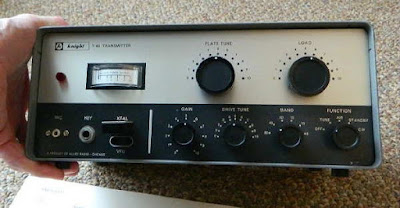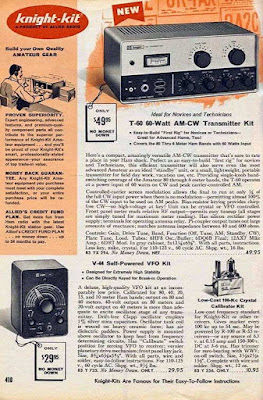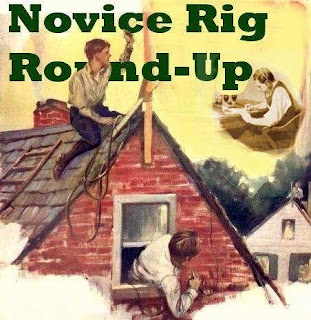Author Archive
 Hunting For NDBs In CLE 230
Hunting For NDBs In CLE 230
 |
| ZSJ - 258 courtesy: http://www.ve3gop.com/ |
This coming weekend will see another monthly CLE challenge. This time the hunting grounds will be: 240.0 - 259.9 kHz and 420.0 - 439.9 kHz.
For those unfamiliar with this monthly activity, a 'CLE' is a 'Co-ordinated Listening Event', as NDB DXers around the world focus their listening time on one small slice of the NDB spectrum.
An easy challenge in this one is to hear the Sandy Lake (ONT) NDB, 'ZSJ', on 258 kHz. At 500W and a 150' vertical, it's well-heard throughout North America. Listen for its upper-sideband CW identifier (with your receiver in the CW mode) on 258.408 kHz.
Hopefully the propagation will co-operate but the Sun has been doing some strange things once again this week, as Cycle 24 continues its downward trend.
If you are interested in building a system for the new (U.S.) 630m band, the CLE will give you the chance to test out your MF receiving capabilities and compare against what others in your area might be hearing.
When tuning for NDBs, put your receiver in the CW mode and listen for the NDB's CW identifier, repeated every few seconds. Listen for U.S. NDB identifiers approximately 1 kHz higher or lower than the published transmitted frequency since these beacons are modulated with a 1020 Hz tone approximately.
For example, 'AA' in Fargo transmits on 365 kHz and its upper sideband CW identifier is tuned at 366.025 kHz while its lower sideband CW ident can be tuned at 363.946 kHz. Its USB tone is actually 1025 Hz while its LSB tone is 1054 Hz.
Often, one sideband will be much stronger than the other so if you don't hear the first one, try listening on the other sideband.
Canadian NDBs normally have an USB tone only, usually very close to 400 Hz. They also have a long dash (keydown) following the CW identifier.
All NDBs heard in North America will be listed in the RNA database (updated daily) while those heard in Europe may be found in the REU database. Beacons heard outside of these regions will be found in the RWW database.
From CLE organizer Brian Keyte, G3SIA, comes the details:
Here are the brief details for our 230th Co-ordinated Listening Event.
In the last Event we used a very big frequency range - 50 kHz.
This time we have 40 kHz to search in, a wide range again, but without QRM from the DGPS beacons and relatively free of NDBs too, all giving us some 'easy listening'?
Days: Friday 23 March to Monday 26 March
Times: Start and end at midday, your LOCAL TIME
Range: 240.0 - 259.9 kHz plus 420.0 - 439.9 kHz
(BOTH ranges are for ALL listeners)
Please listen for the NDBs whose nominal frequencies are in those ranges, plus any UNIDs you hear there.
The LF range will be very challenging from most of Europe.
The HF range will be very challenging from most of North America and from Australia.
S E Asia has some in both ranges.
First-time CLE logs will also be very welcome from anyone, anywhere.
Send your final CLE log to the List, preferably as a plain text email, not in an attachment, with CLE230 and FINAL at the start of its title.
Please show on EVERY LINE of your log:
# The full Date (or Day no.) and UTC (the day changes at 00:00 UTC).
# kHz (show the beacon's nominal published frequency if you know it)
# The Call Ident.
Other optional details, Location, Distance, etc., go LATER in the same line (or in footnotes). Any extra details about UNIDs, especially strong ones that may be near to you (maybe their approximate direction, etc.) will help us to discover more about them. Please make your log useful to old and new members alike by ALWAYS including your own location and brief details of the equipment and aerial(s) that you were using.
Good listening
Brian
---------------------------------------------------------------------
From: Brian Keyte G3SIA ndbcle'at'gmail.com
Location: Surrey, SE England (CLE co-ordinator)
---------------------------------------------------------------------
If you are interested in some remote listening - maybe due to local difficulties - you could use any one remote receiver for your loggings, stating its location and with the owner’s permission if required. A remote listener may NOT also use another receiver, local or remote, to make further loggings for the same CLE.
-------------------------------------------------------------------
These listening events serve several purposes. They:
- determine, worldwide, which beacons are actually in service and on-the-air so the online database can be kept up-to-date
- determine, worldwide, which beacons are out-of-service or have gone silent since the last CLE covering this range
- will indicate the state of propagation conditions at the various participant locations
- will give you an indication of how well your LF/MF receiving system is working
- give participants a fun yet challenging activity to keep their listening skills honed
*** NEWS FLASH ***
The Yahoo ndblist Group has just been moved to Groups.io and The NDB List Group will now be found there! The very active group is a great place to learn more about the 'Art of NDB DXing' or to meet other listeners in your region. There is a lot of good information available there and new members are always very welcome. As well, you can follow the results of other CLE participants from night to night as propagation is always an active topic of discussion.
You need not be an NDB List member to participate in the CLEs and all reports, no matter how small, are of much value to the organizers.
Remember - 'First-time' logs are always VERY welcome!
Reports may be sent to the NDB List Group or e-mailed to CLE co-ordinator, Brian Keyte (G3SIA), whose address appears above. If you are a member of the group, all final results will also be e-mailed and posted there.
Please ... give the CLE a try ... then let us know what NDB's can be heard from your location! Your report can then be added to the worldwide database to help keep it up-to-date.
Have fun and good hunting!
 My 2018 Novice Rig Roundup (NRR) Highlights
My 2018 Novice Rig Roundup (NRR) Highlights
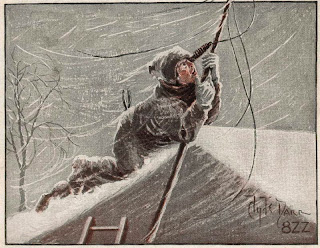 |
| courtesy: arrl.org |
Well this year's NRR has come and gone, providing a full nine days of CW fun for those of us that love old radios.
Once again, the ether filled with signals spawned from the old classic Novice-class workhorses that many of today's 'seasoned' amateurs used in their first stations, way back in their teen years. In many respects, the NRR is as close to a real time machine that you'll find, allowing participants to experience the joys, and sometimes the frustrations, of operating CW with their favorite old rigs from the past.
For me, just like last year, the NRR once again provided many notable highlights over the nine day event.
Almost topping the list was just experiencing the variety of old classics and hearing how well almost all of them sounded. Numerous Knight T-60s, Drake 2NTs, Heath DX-40s, Johnson Adventurers and Eico 720s, along with a nice variety of homebrew MOPAs and one-tube power oscillators graced the nightly airwaves. These oft-forgotten shelf-queens always seem to develop super-powers, far beyond their expectations, when the NRR rolls around!
I was really surprised to work so many T-60s, a small and inexpensive 60 watt transmitter kit from 1962 using a popular 6DQ6 television sweep tube ... one never expected to achieve such RF greatness! I was very impressed with every one that I heard.
What radio-struck pre-Novice teen, dreaming about getting on the air, could resist a clever ad like this.
Scott, KA9P's 80m T-60 signal sounded as sweet as it looks in his 2018 setup, paired with his Heathkit HR-10B inhaler.
 |
| KA9P 2018 NRR station with RAF Vulcan bomber Type 51 hand pump |
Right up there with the plethora of T-60s was the Drake 2NT, another great sounding radio and also my choice for this year's event. My summer refurbishing project, described here, proved a worthy companion, although my much-treasured VF-1 VFO's short term drift probably had my 2NT getting red in the face whenever I took her off of crystal control to scurry around the band, seeking out the CQ'ers. I've had a love-hate relationship with the VF-1 ever since buying my first one back in '63!
 |
| VE7SL 2018 NRR with 2NT, VF-1 and my Original '63 Vibroplex |
Yet another 2NT packed a powerful punch from West Virginia, keyed by Dave, W3NP, when we exchanged 579 reports on 40m, 45 minutes before sunset.
 |
| W3NP - 2018 NRR setup |
I made three contacts on 15m this year: W5IQS in Texas, K2YWE in Maryland and WN4NRR in Florida, whose S9 reply to my 'CQ NRR' just about took my head off ... what a nice surprise to hear the booming signal from Bry's 2NT powerhouse. Dan, K2YWE, was no slouch either, as his Globe Scout was music to my ears when his signal quickly rose out of the noise just long enough to make the coast-to-coast journey. If the predictions for future solar cycles become reality, there may be many more NRRs before we experience the magic of 15m once again.
 |
| K2YWE's Globe Scout and Adventurer were worked on all three bands! |
My NRR exchanges with George, N3GJ (KA3JWJ) in Pennsylvania, truly demonstrated just how well the low bands were performing. More than an hour before my local sunset, I responded to his 569 40m 'CQ NRR' only to learn that his signal, now reaching a solid 579, was coming from an original Ameco AC-1! This one-tube crystal-controlled power oscillator has, over the years, reached Holy Grail status among many amateurs. Originals are guarded like precious jewels and handed down from father to son ... or in George's case, from uncle to nephew!
 |
| N3GJ and his all powerful original AC-1 |
Heathkits were plentiful too, with the DX-60 seeming to be the rig of choice, often paired with the matching HG-10 VFO. Both Mark, VA7MM and Gary, W8PU, packed a wallop with these fine examples.
 |
| VA7MM - 2018 NRR set-up |
| W8PU - 2018 NRR set-up |
But it wasn't just DX-60s representing Benton Harbor engineering in the NRR. All of these neat old Heaths made it out to the west coast, sometimes on both 40 and 80. KN8RHM's (Rick) HW-16 made it here on 40m with a solid signal almost every night, while KE4OH (Steve) sported a modernized DX-20 in the form of Heath's HX-11. Steve even received the highly-treasured 'OO' report for his NRR chirp ... good job!
| KN8RHM - HW-16 NRR set-up |
 |
| KE4OH - HX-11 NRR station |
| N3PDT - DX-40 NRR transmitter |
Rich, WN7NRR / AG5M operating in nearby Washington state put some of his 44 crystals to work with his HW-16 ... that's some collection!
| WN7NRR - HW-16 NTT set-up |
Howie, WB2AWQ in Reno, was using his homebrew pair of 807s, driven with a Millen 90700 swing-arm VFO from 1945. Most shacks worldwide, including the Novices, found plenty of use for the 807 as they were dirt-cheap in the post war surplus market. The filament has a beautiful illumination and if a bit gassy as most are by now, emit a wonderous blue glow with each press of the key.
 |
| WB2AWQ - 807s |
 |
| Millen VFO from 1945 at WB2AWQ |
| KD7JG's 1625 NRR mainstay |
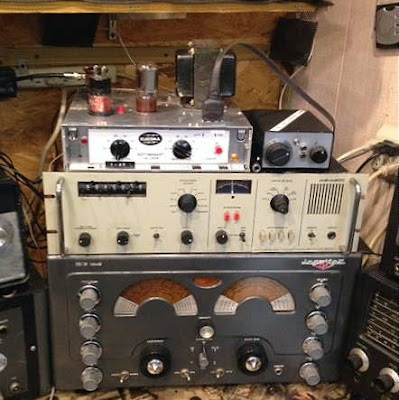 |
| K4IBZ's 10 watter |
 |
| AA8V's homebrew NRR stack |
 |
| VE3BDV / VE3AWA - 50C5 Bare - Essentials power oscillator |
I finished up the NRR with 123 contacts, a lot better than last year's event when I was running the Longfeller at 5 watts.
If you think that you might enjoy participating in the next event then now is the time to start preparing ... just 353 more sleeps until the 2019 NRR begins!!
 Condo Hamming, The NRR and Ron’s Logs
Condo Hamming, The NRR and Ron’s Logs
 |
| courtesy: K4VRC Group |
Rick, KB2NAT, describes the learning curve in his 'How To Overcome Some Condo Issues' post.
Amateurs contemplating downsizing to a restricted development or those finding themselves in a similar situation to Rick will likely soon be subjected to more noise, less space, more neighbours and an abundance of rules. Hopefully the comments of Rick and others will be helpful if this is your situation.
For many restricted hams, Mag loops appear to be a popular choice and one of the comments points to a good deal of information on building one for yourself. The Villages Amateur Radio Club (K4VRC) group's 'resources' link will provide some interesting ideas for restricted antenna builders. As well, they have put together an informational presentation, full of great antenna ideas for those contemplating ways to get on the air from antenna-restricted locations.
If you live in the USA, the 'Freedom to Display the American Flag Act of 2005' has been used by many antenna-restricted hams, to legally erect their own 'antenna flagpole'! It may be an easy route for a nice antenna system for you as well.
The 'Novice Rig Roundup' Starts Tomorrow!

Just a reminder that 9 days of CW operating fun begins tomorrow afternoon. After last year's most enjoyable event, the NRR is now one of my 'must do' operating activities. You can read all about it here.
Ron's Logs
 |
| courtesy: California State Parks |

Ron lives in the seaside city of Monterey (CA) and on most mornings he makes the short pre-dawn drive to Asilomar State Beach (CA), a spectacular location on the coast.
After stringing out his 100' wire antenna on the nearby fence posts, Ron proceeds to log and record some truly exotic stuff before heading home.
Early last Fall, before being aware of Ron's daily regime, I had visited his exact location and after watching the big sea lions playing in the surf, had drooled over the location's great DX potential, little knowing that Ron had likely packed his gear up a headed home just a few hours before my arrival! I'm sure you'll be inspired to tune around the SW broadcast bands after checking out theses Group's daily posts.
 Hunting For NDBs In CLE 229
Hunting For NDBs In CLE 229
| YPM - 274 courtesy: VE3GOP |
This coming weekend will see another monthly CLE challenge. The hunting grounds will be the 50 kHz swath from 270 - 319.9 kHz, with much of this is being shared by DGPS signals here in North America.
The last time this range was covered was in CLE 212, back in October 2016. Conditions were particularly disturbed back then, as described in my CLE 216 Results blog at the time. Propagation should be much better this time, I hope!
For those unfamiliar with this monthly activity, a 'CLE' is a 'Co-ordinated Listening Event', as NDB DXers around the world focus their listening time on one small slice of the NDB spectrum.
A nice challenge in this one is to hear the Pikangikum (ON) NDB, 'YPM', on 274 kHz. Although just a 25-watter, thanks to its large vertical, YPM is well-heard throughout North America. Will you log it as well?
Look for 'YPM's upper-sideband CW identifier, repeated every 10.5 seconds, on 274.352 kHz with your receiver in the CW mode.
If you are interested in building a system for the new (U.S.) 630m band, the CLE will give you the chance to test out your MF receiving capabilities and compare against what others in your area might be hearing. You will soon know how well your system is hearing.
When tuning for NDBs, put your receiver in the CW mode and listen for the NDB's CW identifier, repeated every few seconds. Listen for U.S. NDB identifiers approximately 1 kHz higher or lower than the published transmitted frequency since these beacons are modulated with a 1020 Hz tone approximately.
For example, 'AA' in Fargo transmits on 365 kHz and its upper sideband CW identifier is tuned at 366.025 kHz while its lower sideband CW ident can be tuned at 363.946 kHz. Its USB tone is actually 1025 Hz while its LSB tone is 1054 Hz.
Often, one sideband will be much stronger than the other so if you don't hear the first one, try listening on the other sideband.
Canadian NDBs normally have an USB tone only, usually very close to 400 Hz. They also have a long dash (keydown) following the CW identifier.
All NDBs heard in North America will be listed in the RNA database (updated daily) while those heard in Europe may be found in the REU database. Beacons heard outside of these regions will be found in the RWW database.
Here are the final details from CLE organizer Brian Keyte, G3SIA:
Hello all
Our 229th co-ordinated listening event is this weekend, covering a 50 kHz
frequency range - about three times wider than usual.
Days: Friday 23 February - Monday 26 February
Times: Start and end at midday, your LOCAL time
Range: 270.0 - 319.9 kHz
Targets: NDBs (NOT the DGPS beacons)
We can expect very good propagation, but in part of the frequency range
it might be quite a challenge to tease out the NDB signals from among
the DGPS ones.
Any first-time CLE logs will be very welcome, as always.
Please log the normal NDBs you can identify that are listed in the range
(it includes 270 kHz but not 320 kHz).
Please send your CLE log to NDB List, if possible as a plain text email
and not in an attachment, with 'CLE229 FINAL' at the start of its title.
Show on EVERY line of your log:
# The Date (e.g. '2018-02-23' or just '23', etc.)
# UTC (the day changes at 00:00 UTC).
# kHz - the beacon's nominal published frequency if you know it.
# The Call Ident.
Those main items can be in any order within themselves, but BEFORE any
other optional details (Location, Distance, etc.) later in the same line.
As always, give details in your log of your own location and the receiver,
aerial(s), etc. that you were using.
If you send any interim logs, be sure to send a FINAL (complete) one.
You can find anything else to help you, including seeklists for your part
of the World, from the CLE page, http://www.ndblist.info/cle.htm
Joachim or I will send the usual 'Any More Logs?' email at about 18:00 UTC
on Tuesday so that you can check that your CLE log has been found OK.
Do make sure that your log has arrived at the very latest by 09:00 UTC
next Wednesday, 28th February.
We are hoping to make all the combined results on that day.
Enjoy your listening
Brian
----------------------------------------------------------
From: Brian Keyte G3SIA ndbcle'at'gmail.com
Location: Surrey, SE England (CLE coordinator)
----------------------------------------------------------
(Reminder: You could use any one remote receiver for your loggings,
stating its location and owner - with their permission if required.
A remote listener may NOT also use another receiver, whether local
or remote, to obtain further loggings for the same CLE).
Our 229th co-ordinated listening event is this weekend, covering a 50 kHz
frequency range - about three times wider than usual.
Days: Friday 23 February - Monday 26 February
Times: Start and end at midday, your LOCAL time
Range: 270.0 - 319.9 kHz
Targets: NDBs (NOT the DGPS beacons)
We can expect very good propagation, but in part of the frequency range
it might be quite a challenge to tease out the NDB signals from among
the DGPS ones.
Any first-time CLE logs will be very welcome, as always.
Please log the normal NDBs you can identify that are listed in the range
(it includes 270 kHz but not 320 kHz).
Please send your CLE log to NDB List, if possible as a plain text email
and not in an attachment, with 'CLE229 FINAL' at the start of its title.
Show on EVERY line of your log:
# The Date (e.g. '2018-02-23' or just '23', etc.)
# UTC (the day changes at 00:00 UTC).
# kHz - the beacon's nominal published frequency if you know it.
# The Call Ident.
Those main items can be in any order within themselves, but BEFORE any
other optional details (Location, Distance, etc.) later in the same line.
As always, give details in your log of your own location and the receiver,
aerial(s), etc. that you were using.
If you send any interim logs, be sure to send a FINAL (complete) one.
You can find anything else to help you, including seeklists for your part
of the World, from the CLE page, http://www.ndblist.info/cle.htm
Joachim or I will send the usual 'Any More Logs?' email at about 18:00 UTC
on Tuesday so that you can check that your CLE log has been found OK.
Do make sure that your log has arrived at the very latest by 09:00 UTC
next Wednesday, 28th February.
We are hoping to make all the combined results on that day.
Enjoy your listening
Brian
----------------------------------------------------------
From: Brian Keyte G3SIA ndbcle'at'gmail.com
Location: Surrey, SE England (CLE coordinator)
----------------------------------------------------------
(Reminder: You could use any one remote receiver for your loggings,
stating its location and owner - with their permission if required.
A remote listener may NOT also use another receiver, whether local
or remote, to obtain further loggings for the same CLE).
__._,_.___
Posted by: "Brian Keyte" <9sm@waitrose.com>
These listening events serve several purposes. They:
- determine, worldwide, which beacons are actually in service and on-the-air so the online database can be kept up-to-date
- determine, worldwide, which beacons are out-of-service or have gone silent since the last CLE covering this range
- will indicate the state of propagation conditions at the various participant locations
- will give you an indication of how well your LF/MF receiving system is working
- give participants a fun yet challenging activity to keep their listening skills honed
Final details can be found at the NDB List website, and worldwide results, for every participant, will be posted there a few days after the event. If you are a member of the ndblist Group, results will also be e-mailed and posted there.
The very active Yahoo ndblist Group is a great place to learn more about the 'Art of NDB DXing' or to meet other listeners in your region. There is a lot of good information available there and new members are always very welcome. As well, you can follow the results of other CLE participants from night to night as propagation is always an active topic of discussion.
You need not be an ndblist member to participate in the CLEs and all reports, no matter how small, are of much value to the organizers.
'First-time' logs are always VERY welcome!
Reports may be sent to the ndblist or e-mailed to either myself or CLE co-ordinator, Brian Keyte (G3SIA), whose address appears above.
Please ... give the CLE a try ... then let us know what NDB's can be heard from your location! Your report can then be added to the worldwide database to help keep it up-to-date.
Have fun and good hunting!
__._,_._
 The 2018 Novice Rig Roundup (NRR)
The 2018 Novice Rig Roundup (NRR)
One of the most enjoyable operating events of the year is fast approaching -- the Novice Rig Roundup or 'NRR'. Technically, it is a contest, but I have the feeling that most participants think of it as just a lot of fun and a nice opportunity to hear and work some of the great old 'classics' of the past -- rigs that were used when they were teenage Novices or rigs that they could only drool about owning, back in those formative years when they each discovered the magic of radio.
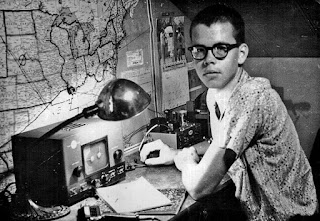 |
| WN4HQW's '62 Novice station (now N4CF) |
The dates to remember are 0000 UTC March 3 - 2359 UTC March 11 and this multi-day opportunity is, for me, what makes the NRR so enjoyable. With a nice diversion from the usual 'contest frenzy' associated with standard weekend operating events, the NRR can be enjoyed throughout the week, whenever you choose to participate. If last year's operating patterns continue, you should find activity at any time of the day ... and even more as sunset arrives.
With the fast-approaching solar minimum, we will be hard-pressed to relive the glory days of worldwide 15m propagation, as even last year's event proved to be tough on this band. With a little luck and, hopefully, a well-timed solar flare, we may get lucky! If you operate during the daylight hours, please get on 15m and give it a shot ... and be sure to announce your activity on the NRR's sked and chat page here, so that others will know where to find you, especially if you are rock bound in true Novice fashion. With our present spotty conditions, we need all the help we can get and the sked page proved a very valuable asset during last year's affair.
Although technically not required, if you plan to participate it's best to obtain your own NRR number, which is an easy 30-second process.
Additionally, there is an online logger where participants can post their daily log. The nifty logger also keeps track and figures out your score as it goes and no 'after contest' log needs to be submitted. If you plan on submitting a log, the logger is a requirement. The logger will also require you to set up a 'log-in' and once again, a simple 30-second process will take care of that from here.

Stations may run either crystal-control or VFO or can switch between either method ... the online logger will keep track and score things appropriately. Stations running in both Novice 1 and Novice 2 categories (probably most common), will be eligible for prizes in both modes if they make at least ten contacts using a Novice 1 station or if they work ten Novice 1 category stations.
All of the rules and information can be found on the NRR's excellent website. As well, the soapbox comments and station pictures from last year's NRR may provide the inspiration that you need to spark-up your own activity in this year's event ... from what I can tell, this year will be bigger and busier than ever!
There is also a dedicated NRR Yahoo Group, often the source of much valuable discussion.
Last year I ran my homebrew Longfeller in the (now eliminated) QRP category, and had a ton of fun. You can read about it here. This year, I have refurbished a nice Drake 2NT that had been gathering dust in the basement for over 25 years ... it's all ready to go now, but a problem with the VF-1 VFO has arisen. The combination works well on 40m and above but on 80 it's a different story. The VFO runs on 160m and it seems that the 2NT balks at the idea of doubling in the buffer stage to 80m. Unless I solve the problem, I'll be rockbound on 3579, 3550 or 3560kc. ... it was 'kilocycles' back then, which always seemed to make more sense to me than 'kilohertz'.
If you have access to the web while operating, be sure to bookmark and check-in to the NRR's realtime chat page. Many ops that are crystal controlled will announce their operating frequencies, making it easier for you to find them ... sometimes way up or down from the normal NRR watering holes of ~ 3550 - 3650 kHz, 7100 -7125 kHz, 21.100 - 21.150 MHz and 28.114, 28.120 MHz ... and don't forget to check the colorburst crystal frequency of 3579!
Of course with the large number of rockbound stations (on crystals), be sure to look above and below these frequencies. It's good practice to listen well above and below your own frequency as well, for anyone answering your CQ who may be up or down the band on crystal control. Unlike today, this was very common practice back in the Novice days!
 |
| courtesy: Harry - VE7AIJ |
You still have time to get that old clunker on the air but if that's not possible, you can join the fun with your modern rig as well ... all are welcome to jump in and have a great week of radio-fun. I think you will be surprised, just as I was last year, how good some of these old classics can sound ... and you'll hear some great bug-fists as well.
As indicated on the NRR website, this is "more of an EVENT than just a typical contest ... once again taking our OLD ham radios off the shelf and putting them to use again! "
See you in the 2018 NRR!
 FCC’s Noise Floor ‘Study’?
FCC’s Noise Floor ‘Study’?

It seems like the FCC's recent interest in doing an in depth study of the growing RF spectrum noise floor has taken a new twist.
The FCC's apparent lack of real action in gathering the data needed to make serious inroads into RF noise pollution has drawn the attention of the ARRL, which voiced their concerns in a recent ARRL Letter as well as in their formal response to the FCC.
In response to the FCC's Public Notice (ET Docket No. 17-340) Spectrum Management proposals.
The ARRL "took the opportunity to strongly urge the FCC to reinstate a 2016 TAC noise floor study, which, ARRL asserted, apparently was terminated before it even got started." It would seem that the proposed in-depth study never even happened and the term 'noise' has morphed into an 'interference' issue!
The FCC's paper proposed a number of guiding 'principles' in going forward with spectrum management policies, loosely based on the concept that more emphasis on eliminating 'interference' should be placed on receivers along with continued development of transmitter spectral purity and that with increased spectrum crowding, users will simply have to expect and accept certain, as yet unspecified, levels of interference!
It sounds suspiciously as if the FCC has decided that the source of any noise / interference problems have become too large to control and have passed the buck to equipment manufacturers in order to solve the growing problem for users!
“Indeed, it is difficult to imagine how the Commission can now…suggest the adoption of specific spectrum management principles, incorporating such concepts as receiver immunity, HCTs [harm claim thresholds], and interference temperature determinations without having…a firm grasp on ambient noise levels in basic RF environments and geographical areas,” the League told the FCC.
In their series of guiding principles relating to 'interference realities', the FCC has issued a number of broad, somewhat ambiguous statements, that might be interpreted in any number of odd ways ...
"Principle #1 -- Harmful interference is affected by the characteristics of both a transmitting service and a nearby receiving service in frequency, space or time;
Principle #2 – All [radio] services should plan for non-harmful interference from signals that are nearby in frequency, space or time, both now and for any changes that occur in the future;
Principle #3 – Even under ideal conditions, the electromagnetic environment is unpredictable. Operators should expect and plan for occasional service degradation or interruption. The Commission should not base its rules on exceptional events;
Principle #4 – Receivers are responsible for mitigating interference outside their assigned channels;
Principle #5 – Systems are expected to use techniques at all layers of the stack to mitigate degradation from interference;
Principle #6 – Transmitters are responsible for minimizing the amount of their transmitted energy that appears outside their assigned frequencies and licensed areas;
Principle #7 – Services under FCC jurisdiction are expected to disclose the relevant standards, guidelines and operating characteristics of their systems to the Commission if they expect protection from harmful interference;"
The ARRL response argued that:
“Requiring better performance from receivers or RF-susceptible devices is a valid, reasonable, and long overdue requirement,” ARRL said, “but the major goal of doing so should be to prevent instances of interference ..."
Specifically they argue that amateurs are unique users and able to recognize harmful interference beyond their control and should not be subjected to the same restrictions (ie. get ready to accept new levels of yet undefined interference levels) as commercial users.
"ARRL argued, however, that the Amateur Service should not be subject to receiver immunity standards, because licensees employ a wide range of propagation, emissions, bandwidths, power levels, receivers, and antennas, making any receiver performance standards arbitrary and compromising the Service’s experimental nature. They also are able to differentiate between interference from nearby spurious or out-of-band signals and that caused by receiver deficiencies. The HCT concept does not fit the Amateur Service particularly well, either, the League said; any interference hams suffer from each other is resolved cooperatively. Brute-force overload also occurs occasionally but is resolved by licensees without FCC intervention."
The ARRL seems somewhat forgetful when it comes to several long-standing complaints of inappropriate amateur-generated interference and bad behaviours which have been ignored for far too long ... problems well beyond 'cooperative resolution' by affected amateurs.
Although the ARRL does agree with many of the FCC's proposals, they doggedly insist that the FCC's apparent quashing of their original noise data investigations is critical to going forward:
“That, in ARRL’s view, is a big mistake,” the League contended. “No system of spectrum management incorporating [harm claim thresholds] and receiver immunity levels can be accurately implemented” without the noise study data.
“That study is more important now than ever before,” ARRL concluded, “and it is increasingly urgent as a prerequisite for any new spectrum management policies.”
With Washington's drastic cutbacks in FCC field-office investigators and overall budget trimming, it seems that the FCC is still relentlessly driven to eradicate all forms of illegal (pirate) broadcasting. It's a pity that they don't display the same zeal for dealing with the illegal imports and distribution of the offshore equipment that is quickly killing our ability to hear anything on the ham bands ... without selling-off and moving to several acres in the country.
 CLE 228 Results
CLE 228 Results
 Last weekend's CLE yielded a mixed-bag of propagation. Friday night's conditions were the best of the three nights here in southwest B.C., but others found things a little different ... such are the vagaries of radio's magic.
Last weekend's CLE yielded a mixed-bag of propagation. Friday night's conditions were the best of the three nights here in southwest B.C., but others found things a little different ... such are the vagaries of radio's magic.All told, I logged 40 NDBs in the specified frequency ranges, with five of the logs being all time 'new catches'. After chasing NDBs regularly since the mid-80's, new ones do not come along too often. It's now fairly clear that as the Sun seriously starts to quiet down once again, propagation on the lower bands, especially the MF and LF part of the spectrum, is quickly improving ... a nice change over the past several years of continuous prop-killing geomagnetic activity during the downhill slide of Cycle 24. It looks as though things will be much better over the next several years as things get even quieter.
The highlight of the weekend was 'TOY' - 260kHz, from Tongoy, Chile. Although on the air for many years, this was the first time I have ever heard it ... on both Friday and Sunday evenings.
Located in coastal central Chile, 'TOY' runs some serious power at 3,000 watts. Along with its large vertical and rural location, I'm surprised I haven't heard it before.
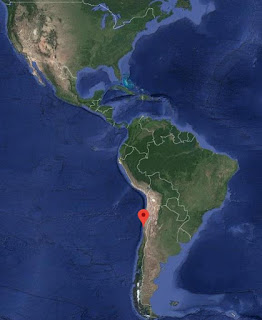 |
| Tongoy, Chile courtesy: https://www.google.ca/maps |
The nearby airstrip in seaside Tongoy is apparently no longer in service and the beacon appears to be an 'enroute' navigational beacon, similar to the high-powered ones in many unpopulated regions of northern Canada.
 |
| TOY-260 courtesy: https://www.google.ca/maps |
 |
| Tongoy Airstrip courtesy: https://www.google.ca/maps |
I have to wonder just how long beacons of this type will be useful enough to maintain as most aero navigation is now reliant on much more accurate GPS, RNAV and RNP systems ... time will tell, but NDBs appear to be going silent with increasing frequency throughout North America.
Another highlight was 500-watter 'QY'-263kHz, located in the heart of Sydney, Nova Scotia and not logged here since 2013. 'QY's large vertical appears to be located in a residential area, but perhaps the beacon was there long before the neighbours moved in. I'll put 'QY' into the receiver's memory as a good indicator of propagation to the east.
 |
| QY-263 Sydney, NS courtesy: https://www.google.ca/maps |
Logged using the Perseus SDR and inverted-L tuned to 300 kHz:
27 08:00 260.0 TOY Tongoy, CHL
27 08:00 260.0 ZXS Prince George, BC, CAN
27 08:00 260.0 YSQ Atlin, BC, CAN
27 06:00 260.0 MTH Marathon, FL, USA
27 06:00 260.0 JH Jackson, MS, USA
27 07:00 260.0 SNE Santa Elena, TX, USA
27 08:00 261.0 D6 Fairmont Hot Springs, BC, CAN
27 08:00 263.0 OAY Norton Bay, ALS
27 06:00 263.0 CVM Alton, IL, USA
27 10:00 263.0 3Z Russell, MB, CAN
27 07:00 263.0 BF Scottsbluff, NE, USA
27 06:00 263.0 QY Sydney, NS, CAN
27 10:00 263.0 YBB Kugaaruk, NU, CAN
27 07:00 263.0 ZQT Thunder Bay, ON, CAN
27 11:00 264.0 SZT Sandpoint Apt, ID, USA
27 08:00 264.0 ZPB Sachigo Lake, ON, CAN
27 10:00 266.0 ICK Annette Island, ALS
27 14:00 266.0 XD Edmonton, AB, CAN
27 14:00 266.0 VR Vancouver, BC, CAN
27 05:00 266.0 BZ Bozeman, MT, USA
27 08:00 266.0 GH Fort Good Hope, NT, CAN
27 07:00 266.0 SLE Salem, OR, USA
29 09:00 266.0 PYX Perryton Ochiltree Co Apt, TX, USA
27 05:00 268.0 ZWL Wollaston Lake, SK, CAN
27 05:00 269.0 YK Castlegar, BC, CAN
29 10:00 269.0 BEX Bloomfield, IA, USA
27 06:00 269.0 UDE Delta Station, MB, CAN
27 06:00 269.0 PK Park Rapids, MN, USA
27 14:00 269.0 ZW Teslin, YT, CAN
27 07:00 512.0 HMY Lexington, OK, USA
27 07:00 515.0 OS Columbus, OH, USA
27 06:00 515.0 PN Ponca City, OK, USA
27 07:00 515.0 CL Cresent Beach, WA, USA
27 05:00 516.0 YWA Petawawa, ON, CAN
27 07:00 521.0 ORC Orange City, IA, USA
27 05:00 524.0 MNL Valdez, ALS
27 05:00 524.0 HRD Hardin, TX, USA
27 07:00 525.0 ICW Nenana, ALS
27 05:00 529.0 SQM Sumner Strait, ALS
27 13:00 529.0 FDV Nome, ALS
The logs / reports from all participants may be viewed (once they have been posted) here on the NDB List website.
